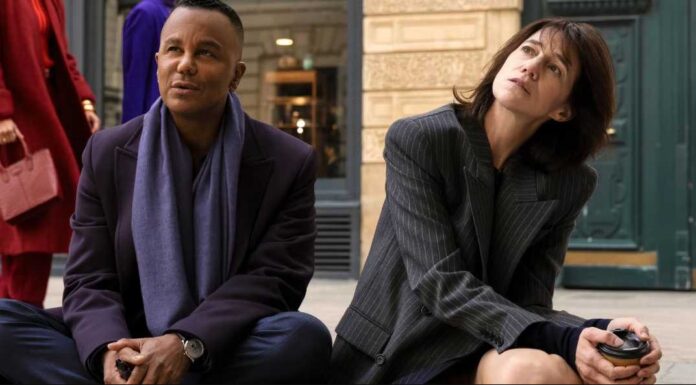Imagine a world where the delicate grace of ballet collides with the raw tension of rivalry, where every pirouette could be a step toward triumph or disaster. Enter Étoile, the latest creation from Amy Sherman-Palladino and Daniel Palladino, the masterminds behind Gilmore Girls and The Marvelous Mrs. Maisel. Premiering on Prime Video on April 24, 2025, this eight-episode series is a whirlwind of pointe shoes, ambition, and sharp-witted humor. Set against the glittering backdrops of New York City and Paris, Étoile spins a tale of two ballet companies swapping their star dancers in a bold, desperate bid to save their legacies. But will this grand jeté into the unknown land in glory or collapse in chaos?
ÉTOILE PLOT: TWO CITIES, TWO COMPANIES, ONE RISKY SWAP
Étoile kicks off with a crisis. The Paris-based ballet company, led by the unrelenting artistic director Geneviève Lavigne (played by Charlotte Gainsbourg), is on the verge of collapse. The COVID-19 pandemic has hollowed out her troupe, and the audience, she says bluntly, is either “dead or dying.” Across the Atlantic, the Metropolitan Ballet Theater in New York is facing its own artistic drought and financial stagnation.
The solution? A PR stunt that could either save or sink them: an international exchange of top-tier dancers. Orchestrated not by artistic vision but by a corporate donor seeking redemption from an oil spill scandal, this swap is less about culture and more about clicks and relevance. Geneviève agrees to the deal, sending her prima ballerina Cheyenne Toussaint (Lou de Laâge) to NYC, while Paris welcomes the American ensemble with wary arms.
Cue the chaos.
Tobias Bell (Gideon Glick), a quirky and neurotic choreographer, is quickly thrown off by the lack of his usual toiletries in Paris. Meanwhile, the French dancers arriving in New York experience a city that never sleeps and doesn’t bow to tradition. One of them, Mishi (Taïs Vinolo), finds unexpected comfort in the Big Apple, realizing her Parisian upbringing had stifled her individuality.
Cheyenne, meanwhile, forms a heartwarming bond with a young girl, the daughter of a cleaning woman who secretly practices ballet in the rehearsal room after hours. Taking the girl under her wing, Cheyenne pushes for her enrollment in the academy, coaching her with fierce love and technical criticism. These interwoven stories give Étoile its soul—offering moments of humor, cultural misunderstanding, and profound connection.
But this show isn’t just about dancing; it’s about adapting, breaking boundaries, and redefining success in an art form known for its rigidity.
IS ÉTOILE BASED ON A TRUE STORY?
Though Étoile is a fictional tale with a whimsical and satirical spin, its core premise isn’t entirely pulled from thin air. In fact, history holds a fascinating precedent: a real-life Cold War ballet exchange that echoed many of the show’s themes, albeit under drastically different circumstances.
In the 1950s and 60s, at the peak of Cold War tension, ballet became a surprising bridge between two ideologically opposed superpowers—the United States and the Soviet Union. Both governments, recognizing the soft power of cultural diplomacy, arranged for their prestigious ballet companies to tour each other’s countries.
Anne Searcy, author of Ballet in the Cold War: A Soviet-American Exchange, outlines the delicate politics behind the pirouettes. “People on either side thought it would lead to more peaceful relationships,” she explains. With Nikita Khrushchev leading a more open Soviet Union than Stalin before him, ballet—deeply rooted in Russian culture—was deployed as a symbol of national sophistication and unity. America, eager not to be outdone, responded in kind.
Thus, in a whirlwind of diplomatic dance, 53 members of the American Ballet Theatre traveled to the Soviet Union, performing selections like Swan Lake, Don Quixote, and George Balanchine’s Theme and Variations. Among them was the legendary ballerina Maria Tallchief, who famously joked that the Russian stages were so cold, she couldn’t feel her feet.
The Soviets returned the favor, bringing iconic works like Giselle, Romeo and Juliet, and Stone Flower to American audiences. The cultural impact was enormous. TIME magazine reported massive demand for tickets—scalpers charged up to $150 (a whopping $1,500 today). There were even reports of telephone operators quitting their jobs due to the high volume of calls from desperate ballet fans.
But not every performance dazzled. The Soviet adaptation of Spartacus was met with boos, with one audience member famously asking, “When will the next orgy begin?” during intermission at the Metropolitan Opera House.
Despite the occasional misstep, the exchange was a diplomatic success. It didn’t end the Cold War, but it did humanize the “enemy.” American audiences saw real Soviet people, not just political caricatures. Likewise, Soviet audiences gained a new respect for American artistry. As Searcy puts it, “There was no winner or loser… but they began to see each other as artists and humans.”
HOW ÉTOILE TURNS HISTORY INTO SATIRE
Where the Cold War exchange was earnest, Étoile is delightfully irreverent. Rather than being state-sponsored, the show’s exchange is fueled by the whims of donors and the desperate machinations of company heads. Instead of national pride, there are branding campaigns and influencer-worthy stunts.
Geneviève, portrayed with icy elegance by Charlotte Gainsbourg, fights to keep her institution afloat while subtly navigating the clash of tradition and modernity. In one moment, she’s discussing funding; in another, she’s refereeing artistic tempers. The New York side, meanwhile, bristles with chaos. Tobias Bell has an emotional meltdown over skincare products. The dancers bicker, flirt, and fumble their way through rehearsals in a new country.
Yet, amid the laughter and absurdity, Étoile captures something real. The physical and emotional toll of dance is shown in full: injuries that threaten careers, the pressure to be perfect, and the fleeting nature of success in a world where you’re only as good as your last performance.
BEHIND THE SCENES: THE MAKING OF ÉTOILE
The Palladinos knew they were stepping into new territory. While Bunheads, Amy Sherman-Palladino’s earlier series, also explored ballet, Étoile delves into the elite, professional realm—a world where one wrong move can end a career.
“This gave us a chance to do a workplace comedy like The Office—but in pointe shoes,” Dan Palladino joked in an interview. “The behind-the-scenes at both Paris and New York, the friction, the camaraderie… we knew there was comedy and heart there.”
The show’s authenticity is bolstered by its cast, including Taïs Vinolo, a former ballerina with the National Ballet of Canada. “Amy and Dan represent the ballet world in a very truthful way,” Vinolo said at PaleyFest in April 2025. “It’s fun, but it’s real.” Non-dancer Ivan du Pontavice, who plays Gabin Roux, immersed himself in ballet for the role and praised the Palladinos’ meticulous research. This blend of realism and humor ensures Étoile resonates with ballet insiders while remaining accessible to newcomers.
For Lou de Laâge, who plays Cheyenne, the role was a double challenge. “I didn’t speak English fluently before this,” she revealed at PaleyFest. Learning the Palladinos’ famously rapid and stylized dialogue was a daunting task. “It was just work and repetition. But eventually, I found the rhythm.”
The show’s blend of languages, accents, and humor adds texture to its world. From petty arguments to life-changing mentorships, every scene pulses with energy—just like a live performance.
As Étoile twirls toward its season finale, it becomes clear that the exchange, despite its rocky start, has made an impact. Cheyenne’s mentorship, Mishi’s newfound independence, and even Tobias’s begrudging respect for Parisian quirks suggest that transformation—real transformation—is possible.
Much like its Cold War predecessor, Étoile ends with no clear victor, just mutual growth and understanding. It’s a comedy, yes, but also a love letter to the grit, grace, and absurdity of the performing arts.
Will it spark a renewed love for ballet? Only time will tell. But one thing is certain: Étoile lands its leap.
Visit tvacute.com again soon for more ÉTOILE updates, insights, and exclusive recaps.







